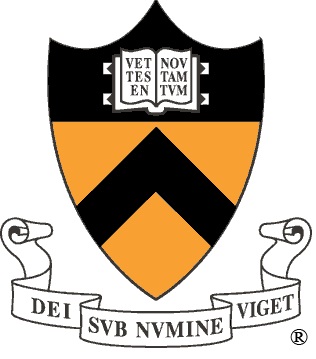RESEARCH PROJECTS
Dynamic Stall
Graduate Student: Victoria Malarczyk
-
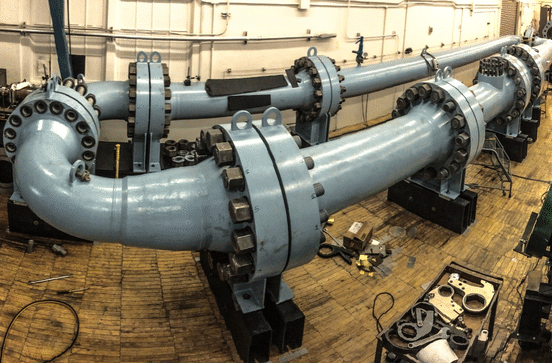 Dynamic stall is an unsteady aerodynamic phenomenon that occurs when an airfoil undergoes a pitching or heaving motion. It is associated with the formation and convection of a vortex from the surface of an airfoil. This phenomenon is still not completely understood due to the complex, non-linear physics of the boundary layer. Victoria is studying the effects of chord Reynolds number (Re), wing three-dimensionality, airfoil shape, and airfoil kinematics on an airfoil undergoing dynamic stall in the variable-density High Reynolds number Test Facility (HRTF). By scaling pressure instead of velocity, the experiments bypass compressibility and time-scale challenges faced by unsteady aerodynamic studies in traditional wind tunnels operating at high Re and atmospheric pressure. Her findings are pertinent to large and small-scale aeronautics, wind energy, and biological flows.
Dynamic stall is an unsteady aerodynamic phenomenon that occurs when an airfoil undergoes a pitching or heaving motion. It is associated with the formation and convection of a vortex from the surface of an airfoil. This phenomenon is still not completely understood due to the complex, non-linear physics of the boundary layer. Victoria is studying the effects of chord Reynolds number (Re), wing three-dimensionality, airfoil shape, and airfoil kinematics on an airfoil undergoing dynamic stall in the variable-density High Reynolds number Test Facility (HRTF). By scaling pressure instead of velocity, the experiments bypass compressibility and time-scale challenges faced by unsteady aerodynamic studies in traditional wind tunnels operating at high Re and atmospheric pressure. Her findings are pertinent to large and small-scale aeronautics, wind energy, and biological flows.
Atmospheric Flow Influence on Insect Flight
Graduate Student: Nick Conlin
-
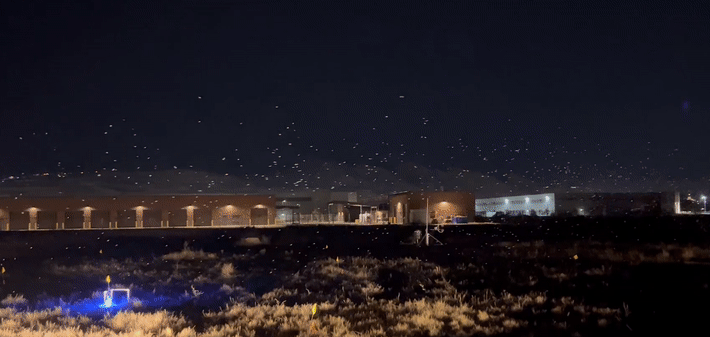 Under natural conditions, many flying insects locate resources vital to survival and reproduction by responding to, and tracking, plumes of scalar cues present in their surroundings (e.g. odors, humidity, temperature, carbon dioxide). The spatio-temporal distribution of the scalar field is a function of turbulence and unsteadiness, that introduce a large range of length and time scales into the flow present in the atmospheric boundary layer (ABL) or in-built environments. Yet, we know very little about the behavioral strategies by which insects accomplish this remarkable feat under the turbulent conditions characteristic of natural habitats. Much of our current understanding of the insect behavioral mechanisms come from no-flow, limited flow, or laminar-flow wind tunnel experiments. Addressing this limitation would have several important implications, including deployment of optimized distraction strategies and innovative tracking strategies for autonomous vehicles in hazardous environments. We are measuring the flow conditions correlated with mosquito activity with an in-house very-large scale bubble velocimetry through field measurements at the Salt lake City Mosquito Abatement District at Utah. In order to reproduce these conditions for controlled wind tunnel studies, a novel, cost-effective turbulence generating grid is under development.
Under natural conditions, many flying insects locate resources vital to survival and reproduction by responding to, and tracking, plumes of scalar cues present in their surroundings (e.g. odors, humidity, temperature, carbon dioxide). The spatio-temporal distribution of the scalar field is a function of turbulence and unsteadiness, that introduce a large range of length and time scales into the flow present in the atmospheric boundary layer (ABL) or in-built environments. Yet, we know very little about the behavioral strategies by which insects accomplish this remarkable feat under the turbulent conditions characteristic of natural habitats. Much of our current understanding of the insect behavioral mechanisms come from no-flow, limited flow, or laminar-flow wind tunnel experiments. Addressing this limitation would have several important implications, including deployment of optimized distraction strategies and innovative tracking strategies for autonomous vehicles in hazardous environments. We are measuring the flow conditions correlated with mosquito activity with an in-house very-large scale bubble velocimetry through field measurements at the Salt lake City Mosquito Abatement District at Utah. In order to reproduce these conditions for controlled wind tunnel studies, a novel, cost-effective turbulence generating grid is under development.
Wind Turbine Wakes
Postdoctoral Researchers: John Kurelek and Nathaniel Wei
-
 As modern wind turbines continue to grow to sizes of nearly 200 meters in diameter, it becomes increasingly difficult to perform computer simulations or laboratory experiments which match all of the governing parameters simultaneously. Prior work has been limited by tradeoffs inherent in the three important non-dimensional numbers for wind-turbine aerodynamics, namely the Reynolds number, tip-speed ratio, and Mach number. In traditional small-scale wind tunnels, these three parameters are impossible to match with the full-scale values. Researchers in the Hultmark lab are using a high-pressure wind tunnel in which the density can be varied, such that the Reynolds number can be adjusted independently of the tip-speed ratio. With this facility, they are able to match the flow physics of full-scale wind turbines in controlled laboratory conditions. The facility is instrumented with a hot-wire traverse which allows detailed studies of the turbine wake. Topics of investigation include the dynamics and wake structure of yaw-misaligned turbines, differences between actuator-disc and turbine wake profiles, and the effects of dynamic induction control on wake recovery.
As modern wind turbines continue to grow to sizes of nearly 200 meters in diameter, it becomes increasingly difficult to perform computer simulations or laboratory experiments which match all of the governing parameters simultaneously. Prior work has been limited by tradeoffs inherent in the three important non-dimensional numbers for wind-turbine aerodynamics, namely the Reynolds number, tip-speed ratio, and Mach number. In traditional small-scale wind tunnels, these three parameters are impossible to match with the full-scale values. Researchers in the Hultmark lab are using a high-pressure wind tunnel in which the density can be varied, such that the Reynolds number can be adjusted independently of the tip-speed ratio. With this facility, they are able to match the flow physics of full-scale wind turbines in controlled laboratory conditions. The facility is instrumented with a hot-wire traverse which allows detailed studies of the turbine wake. Topics of investigation include the dynamics and wake structure of yaw-misaligned turbines, differences between actuator-disc and turbine wake profiles, and the effects of dynamic induction control on wake recovery.
Nonequilibrium Turbulence
Graduate Student: Ian Gunady
-
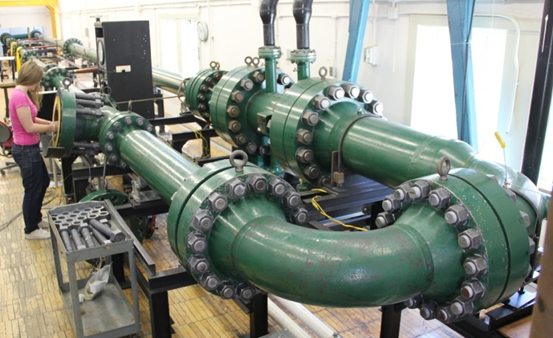 Prior work in the Princeton superpipe has been limited to pipe flow measurements. With Ian's work, an axisymmetric body of revolution that traverses in the streamline direction has been added to the centerline of the superpipe. His research involves studying how Reynolds number, pressure gradients, streamline convergence/divergence, and streamline curvature affect turbulence. Ian is also looking at how Reynolds number affects wake development and recovery.
Prior work in the Princeton superpipe has been limited to pipe flow measurements. With Ian's work, an axisymmetric body of revolution that traverses in the streamline direction has been added to the centerline of the superpipe. His research involves studying how Reynolds number, pressure gradients, streamline convergence/divergence, and streamline curvature affect turbulence. Ian is also looking at how Reynolds number affects wake development and recovery.
Heat Transfer in Liquid Infused Surfaces
Graduate Student: Lena Sabidussi
-
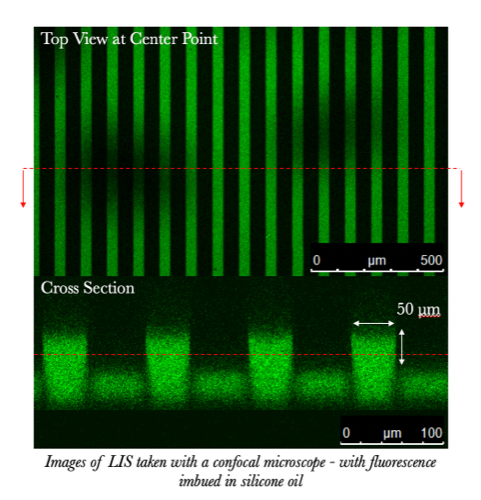 Fouling reduces the performance of many applications that rely on heat transfer, particularly heat exchangers. To combat fouling, polymer coatings with low thermal conductivities are often applied, which further inhibit the performance of these applications. Lena's research presents liquid infused surfaces (LIS) as an interesting option for such coatings. LIS are surfaces that have liquids imbibed within cavities in a solid substrate. By using an immiscible internal liquid, these surfaces create a mobile interface with an external flow. While studied primarily for their drag reducing and antifouling capabilities, Lena studies these surfaces for their potential to enhance convective heat transfer in the surface. She explores various surface modifications and designs to increase internal liquid retention, drag reduction, and heat exchange. These surfaces are tested in laminar flows with microfluidic devices and in turbulent channel flows.
Fouling reduces the performance of many applications that rely on heat transfer, particularly heat exchangers. To combat fouling, polymer coatings with low thermal conductivities are often applied, which further inhibit the performance of these applications. Lena's research presents liquid infused surfaces (LIS) as an interesting option for such coatings. LIS are surfaces that have liquids imbibed within cavities in a solid substrate. By using an immiscible internal liquid, these surfaces create a mobile interface with an external flow. While studied primarily for their drag reducing and antifouling capabilities, Lena studies these surfaces for their potential to enhance convective heat transfer in the surface. She explores various surface modifications and designs to increase internal liquid retention, drag reduction, and heat exchange. These surfaces are tested in laminar flows with microfluidic devices and in turbulent channel flows.
FlowDrone: Improving UAV Flight Control with Proactive Sensing
Graduate Student: Nate Simon
-
 Due to limitations in available sensor technology, unmanned aerial vehicles (UAVs) lack an active sensing capability to measure turbulence, gusts, or other unsteady aerodynamic phenomena. Conventional in situ anemometry techniques are generally unsuitable due to form factor, resolution, or robustness requirements. To address this capability gap, we are working on a fast-response omnidirectional sensor to measure a wind vector for use in wind estimation and control. Our latest system is the `MAST' (for MEMS Anemometry Sensing Tower), which leverages advances in microelectromechanical (MEMS) hot-wire devices to produce a solid-state, lightweight, and robust flow sensor suitable for real-time wind estimation onboard a UAV. The MAST uses five pentagonally-arranged microscale hot-wires to determine the wind vector's direction and magnitude. We use machine learning to learn a neural network that maps from the sensor voltages to the wind vector as calibrated in wind tunnel experiments. Check out this link to see the improvement of our sensor system!
Due to limitations in available sensor technology, unmanned aerial vehicles (UAVs) lack an active sensing capability to measure turbulence, gusts, or other unsteady aerodynamic phenomena. Conventional in situ anemometry techniques are generally unsuitable due to form factor, resolution, or robustness requirements. To address this capability gap, we are working on a fast-response omnidirectional sensor to measure a wind vector for use in wind estimation and control. Our latest system is the `MAST' (for MEMS Anemometry Sensing Tower), which leverages advances in microelectromechanical (MEMS) hot-wire devices to produce a solid-state, lightweight, and robust flow sensor suitable for real-time wind estimation onboard a UAV. The MAST uses five pentagonally-arranged microscale hot-wires to determine the wind vector's direction and magnitude. We use machine learning to learn a neural network that maps from the sensor voltages to the wind vector as calibrated in wind tunnel experiments. Check out this link to see the improvement of our sensor system!

